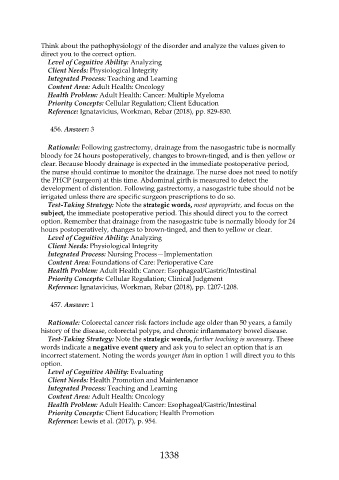Page 1338 - Saunders Comprehensive Review For NCLEX-RN
P. 1338
Think about the pathophysiology of the disorder and analyze the values given to
direct you to the correct option.
Level of Cognitive Ability: Analyzing
Client Needs: Physiological Integrity
Integrated Process: Teaching and Learning
Content Area: Adult Health: Oncology
Health Problem: Adult Health: Cancer: Multiple Myeloma
Priority Concepts: Cellular Regulation; Client Education
Reference: Ignatavicius, Workman, Rebar (2018), pp. 829-830.
456. Answer: 3
Rationale: Following gastrectomy, drainage from the nasogastric tube is normally
bloody for 24 hours postoperatively, changes to brown-tinged, and is then yellow or
clear. Because bloody drainage is expected in the immediate postoperative period,
the nurse should continue to monitor the drainage. The nurse does not need to notify
the PHCP (surgeon) at this time. Abdominal girth is measured to detect the
development of distention. Following gastrectomy, a nasogastric tube should not be
irrigated unless there are specific surgeon prescriptions to do so.
Test-Taking Strategy: Note the strategic words, most appropriate, and focus on the
subject, the immediate postoperative period. This should direct you to the correct
option. Remember that drainage from the nasogastric tube is normally bloody for 24
hours postoperatively, changes to brown-tinged, and then to yellow or clear.
Level of Cognitive Ability: Analyzing
Client Needs: Physiological Integrity
Integrated Process: Nursing Process—Implementation
Content Area: Foundations of Care: Perioperative Care
Health Problem: Adult Health: Cancer: Esophageal/Gastric/Intestinal
Priority Concepts: Cellular Regulation; Clinical Judgment
Reference: Ignatavicius, Workman, Rebar (2018), pp. 1207-1208.
457. Answer: 1
Rationale: Colorectal cancer risk factors include age older than 50 years, a family
history of the disease, colorectal polyps, and chronic inflammatory bowel disease.
Test-Taking Strategy: Note the strategic words, further teaching is necessary. These
words indicate a negative event query and ask you to select an option that is an
incorrect statement. Noting the words younger than in option 1 will direct you to this
option.
Level of Cognitive Ability: Evaluating
Client Needs: Health Promotion and Maintenance
Integrated Process: Teaching and Learning
Content Area: Adult Health: Oncology
Health Problem: Adult Health: Cancer: Esophageal/Gastric/Intestinal
Priority Concepts: Client Education; Health Promotion
Reference: Lewis et al. (2017), p. 954.
1338

